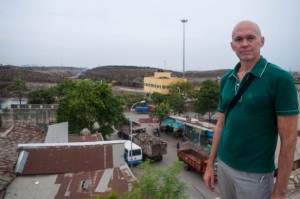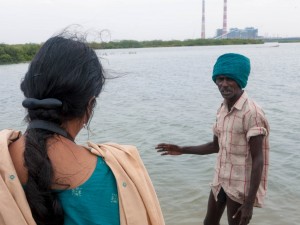South Asian journalists tackle climate change reporting

Kyle James has been conducting DW Akademie workshops in Asia and Central Asia since 2008, covering radio production, multimedia journalism and print.
The smell was nauseating and the sight quite a depressing one. The ten participants of the Climate Change Workshop in Chennai / India, along with the two trainers and our guide, had just scrambled up to the top of a building to get a better view of the Kodungaiyur dumpyard in the northern part of the city. We were there to see how waste disposal, unregulated construction, and short-sighted transportation and energy policies were harming the environment and contributing to climate change by releasing greenhouse gases and paving over important carbon sinks like wetlands.
Kodungaiyur, an area that once featured marshes and cattle grazing land, had been turned into something more befitting Dante’s Inferno—a hazy landscape of rotting garbage, heavy industry and smoke-belching trucks under a relentless, blistering sun. And, it was all located near the homes of about 100,000 people, almost all poor.
 The scene was representative of the myriad environmental problems that India faces, and which are beginning to have real impacts on the wider region. And almost every day during the workshop, the Indian papers carried reports on new environmental problems the country was up against. Chennai’s water table was dropping; fish catches were declining; traffic was increasing. Devastating floods in the northern Indian state of Uttarakhand claimed the lives of an estimated 1,000, while more than 2,800 were still missing at this writing. Some experts said that the kinds of intense storms that washed away bridges, temples and homes there were likely to become more frequent due to the changing climate.
The scene was representative of the myriad environmental problems that India faces, and which are beginning to have real impacts on the wider region. And almost every day during the workshop, the Indian papers carried reports on new environmental problems the country was up against. Chennai’s water table was dropping; fish catches were declining; traffic was increasing. Devastating floods in the northern Indian state of Uttarakhand claimed the lives of an estimated 1,000, while more than 2,800 were still missing at this writing. Some experts said that the kinds of intense storms that washed away bridges, temples and homes there were likely to become more frequent due to the changing climate.
The real-world events happening outside our seminar room were motivating factors for the participating journalists’ from India, Nepal and Bangladesh. But so were the things we witnessed first hand—polluted rivers, eroding beaches, coal-fired power plants—as well as the people we talked to whose lives and livelihoods were hurting because of them. In some ways it was a sobering time, but it highlighted the urgency of communicating the consequences of climate change to the larger public, and perhaps convincing policy makers to take serious action.
Author: Kyle James



